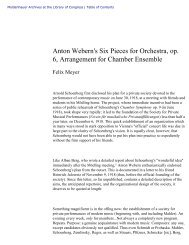Country Profile: Cuba - American Memory - Library of Congress
Country Profile: Cuba - American Memory - Library of Congress
Country Profile: Cuba - American Memory - Library of Congress
Create successful ePaper yourself
Turn your PDF publications into a flip-book with our unique Google optimized e-Paper software.
<strong>Library</strong> <strong>of</strong> <strong>Congress</strong> – Federal Research Division <strong>Country</strong> <strong>Pr<strong>of</strong>ile</strong>: <strong>Cuba</strong>, September 2006<br />
vehicles in operation. Moreover, fuel shortages have forced cutbacks in the number <strong>of</strong> routes and<br />
their frequency. Transportation bottlenecks have affected labor productivity because workers are<br />
unable to get to their jobs on time or have to spend an inordinately long period <strong>of</strong> time<br />
commuting to their jobs.<br />
Roads: By 2000 <strong>Cuba</strong> had an estimated 112,998 kilometers <strong>of</strong> roads, including at least 26,000<br />
kilometers <strong>of</strong> paved roads (but more likely 29,820) and about 84,000 kilometers <strong>of</strong> unpaved<br />
roads, constituting one <strong>of</strong> the most developed road systems in the Caribbean. For five decades,<br />
the main highway was the Central Highway, mostly a two-lane road running for 1,200 kilometers<br />
from Pinar del Río in the west to Santiago de <strong>Cuba</strong> in the east. In the late 1970s, construction<br />
began on a new eight-lane National Expressway (commonly known as “Ocho Vías,” or Eight<br />
Lanes), which was supposed to run the length <strong>of</strong> <strong>Cuba</strong> from Pinar del Río to Santiago de <strong>Cuba</strong>.<br />
However, the Ocho Vías, which lacks lights and is variously reported as in poor to good<br />
condition, extends only two-thirds <strong>of</strong> the way from Havana to the eastern tip <strong>of</strong> the island;<br />
moreover, washed-out sections and giant potholes limit traveling speeds. In addition, the Vía<br />
Blanca links Havana with Varadero, and the Vía Mulata links Baracoa and Santiago de <strong>Cuba</strong> in<br />
<strong>Cuba</strong>’s southeast with the rest <strong>of</strong> the island. Although the main highways <strong>of</strong> Havana are<br />
generally well maintained, secondary streets usually are not.<br />
Railroads: Despite being much more energy efficient than truck transport, particularly in<br />
transporting sugarcane or ore, railroad transportation has been neglected since 1959 in favor <strong>of</strong><br />
truck transport. Although half <strong>of</strong> the rolling stock is in a dilapidated state, the country has an<br />
extensive rail network running the length <strong>of</strong> the island and connecting the large urban areas,<br />
industrial centers, and major and secondary ports, either directly or through branches. In 2004<br />
the rail network for transporting passengers and general freight included 4,226 kilometers <strong>of</strong><br />
1.435-meter standard-gauge track and about 150 kilometers <strong>of</strong> electrified 0.914-meter narrowgauge<br />
track. In addition, the island’s sugar factories and plantations were served in 2004 by<br />
7,742 kilometers <strong>of</strong> private track, about 65 percent standard gauge and the rest narrow gauge.<br />
The total volume <strong>of</strong> rail transport reportedly increased by 13 percent in 2005 with the aid <strong>of</strong> trade<br />
and agreements with China that allowed for repair <strong>of</strong> locomotives and purchases <strong>of</strong> new<br />
equipment.<br />
Ports and Shipping: <strong>Cuba</strong>’s ports are in generally good condition but in need <strong>of</strong> modernization<br />
and dredging. <strong>Cuba</strong> has 11 main ports capable <strong>of</strong> handling general export and import cargoes,<br />
including major deep-water ports at Cienfuegos, Havana, Mariel (the Free Trade Zone),<br />
Matanzas, Nipe, Nuevitas, and Santiago de <strong>Cuba</strong>. In addition, <strong>Cuba</strong> has eight bulk sugar-loading<br />
terminals and several other smaller import facilities, as well as specialized port facilities for the<br />
fishing fleet. Of the country’s most used ports (Cienfuegos, Havana, Mariel, Matanzas, and<br />
Santiago de <strong>Cuba</strong>), Havana is the country’s largest and most frequently accessed, with three<br />
main general cargo facilities that handle container vessels and roll-on/<strong>of</strong>f vessels. During the<br />
1990s, a new pier for cruise ships was built, and in 2001 various cruise ships from British,<br />
Canadian, Italian, and Spanish companies began to make Havana a port <strong>of</strong> call. Number one in<br />
sugar exports, the port <strong>of</strong> Cienfuegos is capable <strong>of</strong> handling one-third <strong>of</strong> <strong>Cuba</strong>’s sugar production<br />
through its bulk sugar terminal. Its pier for handling oil and oil byproducts allows the berthing <strong>of</strong><br />
ships up to 50,000 tons. Matanzas, located on the north coast, has a supertanker terminal with an<br />
20



![Albert Einstein Papers [finding aid]. Library of Congress. [PDF ...](https://img.yumpu.com/21604228/1/190x245/albert-einstein-papers-finding-aid-library-of-congress-pdf-.jpg?quality=85)





![American Colony in Jerusalem Collection [finding aid]. Library of ...](https://img.yumpu.com/17941275/1/190x245/american-colony-in-jerusalem-collection-finding-aid-library-of-.jpg?quality=85)



![Piccard Family Papers [finding aid]. - American Memory - Library of ...](https://img.yumpu.com/17941234/1/190x245/piccard-family-papers-finding-aid-american-memory-library-of-.jpg?quality=85)


